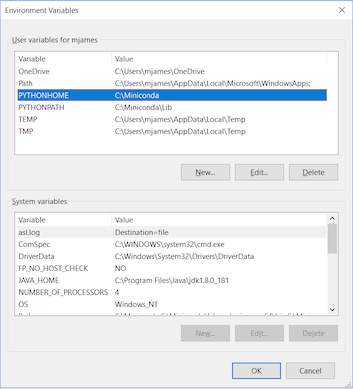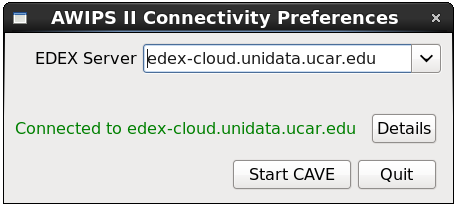-Change the entire layout to have consistent sections for the three OS's: System Requirements and Download and Installation Instructions. -Windows now has two distinct installation methods -Removed RHEL/Centos6 from documention (just say 7) -Added a General Requirements section that is more directed at hardware (not OS specific) -Renamed the caveData section to "Local Cache" -Renamed the AWIPS Data in the Cloud section to "EDEX Connection" -removed all the tables from the previous formatting, just use section headers, ordered and unordered lists, and notes
7.5 KiB
Install CAVE
CAVE is the Common AWIPS Visualization Environment that is used for rendering and analyzing data for AWIPS. Unidata supports CAVE to work on three platforms: Centos (Redhat) Linux, Windows, and macOS. The installer may require administrator priviledges to install and may require other system changes (environment variables, etc) as well.
General Requirements
Regardless of what Operating System CAVE is running on, these general requirements are recommended in order for CAVE to perform optimally:
- OpenGL 2.0 Compatible Devices
- At least 4GB RAM
- At least 2GB Disk Space for Caching
- Latest NVIDIA Driver
Note: NVIDIA Quadro graphics card is recommended for full visualization capability
Linux
System Requirements
- 64 bit CentOS/Red Hat 7
Download and Installation Instructions
- Download the following installer: awips_install.sh
- Go to the download directory and run:
awips_install.sh --cave - Make the installer an executable by running:
chmod 755 awips_install.sh - Run the installer:
sudo ./awips_install.sh --cave- This will install the application in
/awips2/cave/and set the local cache to~/caveData/
- This will install the application in
To run CAVE either:
- Use the terminal and type the command
cave - Find the application in the Linux Desktop menu: Applications > Internet > AWIPS CAVE
Windows
For Windows, Unidata offers two installation options: a Linux Virtual Machine, or a Direct Windows Installation. Currently, the virtual machine is the recommended form of install. The direct installation can work, but currently we do not have complete instructions on how to get jep (which is a python package) running properly with CAVE. Because of this, CAVE will install just fine, but certain data products will not render in the application. The direct install also requires several system modifications and will require administrator priviledges. We are in the process of producing a working set of instructions for the direct install, but as of now just have old instructions, which likely will not have jep working properly.
Method 1: Linux Virtual Machine (Recommended)
System Requirements
- VMWare Workstation Player must be installed (free software)
Download and Installation Instructions
- Download the zipped file containing the virtual machine: unidata_cave.zip
- Unzip the folder by right-clicking and selecting "Extract All". All files will be extracted into a new folder.
- Open VMWare Player and go to Player > File... > Open and locate the folder that was created from the downloaded zipped file. Select the file called "CentOS 7 - Unidata CAVE".
- Run this new VM option. If it asks if it's been moved or copied, select copied.
- There will be a user in the Linux machine named "awips" and the password is "awips"
- The root password is "unidataAWIPS" if ever needed
To run CAVE either:
- Use the desktop icon
- Use the terminal and type the command
cave - Find the application in the Linux Desktop menu: Applications > Internet > AWIPS CAVE
Method 2: Direct Windows Install
System Requirements
- Miniconda3
- Python
- Numpy
- Jep
- PYTHONHOME must be defined
- JAVA_HOME must be defined
- Visual C++ Build Tools 2015 Update 3 (Version 14.1)
Note: Specific instructions are detailed for installing the above, but they still may not install jep properly
Download and Installation Instructions
- Download and install Miniconda Python 3.7 for Windows
- Allow Miniconda3 to set PATH and other environment variables
- Ensure that PYTHONHOME is set to the Miniconda3 location

Note: If PYTHONHOME is not set, the gridslice Python module will not be installed or available
- Download and install Microsoft Visual Studio C++ Build Tools
- To access the page linked above you will need a Microsoft account
- Once at that webpage, search for "build tools c+" in order for the proper download to be returned
- Download Visual C++ Build Tools 2015 Update 3
- Install dependent Python packages
pip install numpy==1.15.1 jep=3.8.2
- Download and install: awips-cave.msi
- In addition to the application directory, the MSI installer will attempt to copy the gridslice shared library to
$PYTHONHOME/Dlls/. If the$PYTHONHOMEenvironmental variable is not defined gridslice will not be installed. You can check to see if it was installed in the Dlls directory after you have completed steps 1-3.
Note: CAVE will still run without gridslice, but certain bundles which use derived parameters, such as isentropic analysis, will not load.
- In addition to the application directory, the MSI installer will attempt to copy the gridslice shared library to
macOS
System Requirements
- NVIDIA Graphics card is recommended, some Intel Graphics cards will working
Note: Most AMD graphics cards are not supported
Download and Installation Instructions
- Download and install both: awips-cave.dmg and awips-python.pkg
- This will install CAVE as an application and set the local cache to
~/Library/caveData
- This will install CAVE as an application and set the local cache to
Note: The awips-python.pkg is not necessarily required, and CAVE will still run without it, but any derived data such as barbs, arrows, and various grid products will not render without having jep installed (it is assumed to be in /Library/Python/2.7/site-packages/jep/)
To run CAVE either:
- Use the System Menu Go > Applications > CAVE
- Type ⌘ + Spacebar and then type "cave", the application should appear and you can hit enter to run it
EDEX Connection
Unidata and XSEDE Jetstream have partnered to offer a EDEX data server in the cloud, open to the Unidata university community. Select the server in the Connectivity Preferences dialog, or enter edex-cloud.unidata.ucar.edu (without http:// before, or :9581/services after).
Local Cache
After connecting to an EDEX server, you will have a local directory named caveData which contains files synced from EDEX as well as a client-side cache for data and map resources.
You can reset CAVE by removing the caveData directory and reconnecting to an EDEX server. Your local files have been removed, but if you are re-connecting to an EDEX server you have used before, the remote files will sync again to your local ~/caveData (bundles, colormaps, etc.).
- Linux:
/home/<user>/caveData/ - macOS:
/Users/<user>/Library/caveData/ - Windows:
C:\Users\<user>\caveData\
